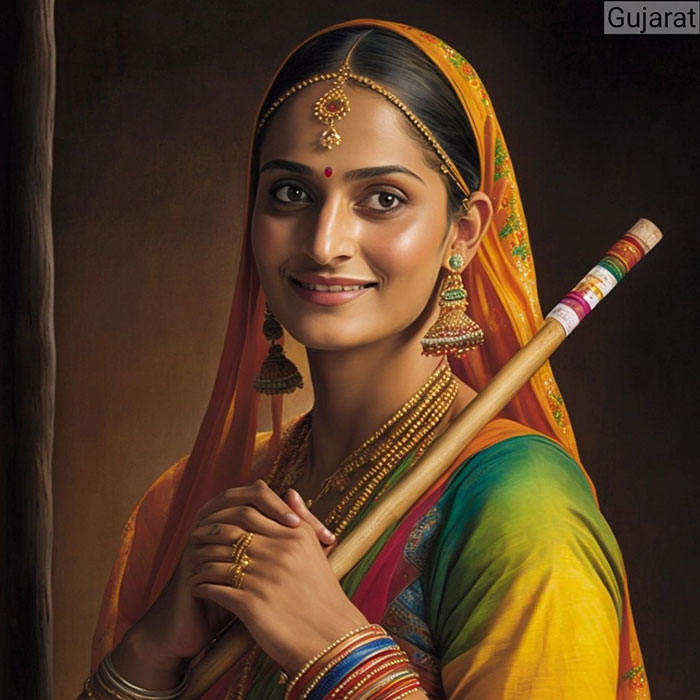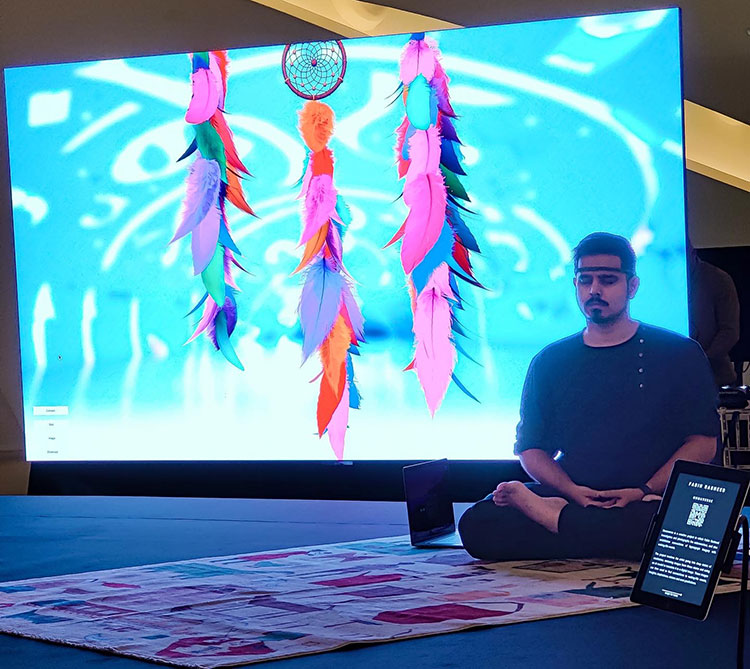‘I’m scared that it will be too good’… How artists are adopting AI tools for their artworks
AI tools such as Dall-E or Stable Diffusion can now generate artwork in seconds. So what does it mean for artists and how are they adopting these new ‘tools’?
 Art can now be created using AI. But what does it mean for artists and how are they engaging with the technology. We explore. (In this picture, stereotypical images of a man from Delhi (L) and a woman from Uttar Pradesh (R) as generated by artist Madhav Kohli and shared on Twitter)
Art can now be created using AI. But what does it mean for artists and how are they engaging with the technology. We explore. (In this picture, stereotypical images of a man from Delhi (L) and a woman from Uttar Pradesh (R) as generated by artist Madhav Kohli and shared on Twitter) What would a stereotypical image of a man from Delhi look like? What about a woman from the state of Uttar Pradesh? And just how does one go about depicting and creating such artwork? Well, if you are an artist in 2023, image generators using artificial intelligence (AI) such as Dall-E or Stable Diffusion appear to be the easiest of solutions. In fact, Gurgaon-based artist Madhav Kohli (24) used Midjourney–another text-image-generator — to create his series of portraits that went viral on Twitter. The portraits showcased how AI would imagine the stereotypical Indian man or woman from each state. And like Kohli, many other artists are now using these AI-based tools to test the boundaries of their own imaginative processes.
On the face of it, these AI art tools seem like fairly simple and easy work. Tools such as OpenAI’s Dall-E or Stable Diffusion allow one to just enter a word prompt say ‘monkey eating a banana in an oil painting style’, and voila, the image is created. Image generators such as Dall-E are based on the generative pre-trained transformer (GPT) technology, where the model relies on deep learning to give human-like responses. So while ChatGPT gives a conversational response, Dall-E ends up creating images in response to word prompts from a user. The models are trained on billions of parameters of datasets and learn from them, and in response create art or essays or even videos.
 A stereotypical image of a woman from Gujarat as generated via AI. (Image created by Madhav Kohli)
A stereotypical image of a woman from Gujarat as generated via AI. (Image created by Madhav Kohli)
However, as artists like Kohli and others vouch, the process of creating this ‘art’ using AI is anything but simple. “The concept and message of the project have to be developed and conceptualised first,” Kohli told indianexpress.com via email, adding that he only used AI tools in the execution of the concept. He still relied on traditional tools such as Adobe Lightroom for the final touches for the portraits though. The process requires some “prompt engineering” as he termed it, and one has to “create and recreate the same piece until you get the desired results.”
“I believe I have put out 100 stereotype pieces but had to make thousands to be able to get those results, which weren’t truly accurate either,” he explained.
According to Dubai-based artist Fabin Rasheed, who has used AI-based tools since 2018, it all depends on how the artist in question uses the tool and it can often go beyond simple text-based prompts. For his instance, his works such as Numaverse translate the images from his subconscious to digital images using AI models.
 For his dreamcatcher project, where the final artwork was created with the help of AI, Fabin wore an EEG device which translated his brainwaves into my computer which then created the sculpture. (Image via Fabin Rasheed)
For his dreamcatcher project, where the final artwork was created with the help of AI, Fabin wore an EEG device which translated his brainwaves into my computer which then created the sculpture. (Image via Fabin Rasheed)
“One of my earlier works was to create a bot called “Auria Kathi” which creates visual art by itself and posts to social media. There is also a work where I created an OTT platform which generates a set of complete short films randomly, on demand, from a language model using GPT3 and GIFs. So it really is a matter of how we use AI as a tool for creative expression,” Rasheed explained in an email on the kind of work he has created.
Rasheed, who started creating digital works around 25 years ago with Macromedia Flash relies on a variety of custom machine learning models to software like Unity, HTML-CSS-JS, Blender, Photoshop, Illustrator, After Effects, and Substance suite for his works. And he is convinced, that the use of AI heralds “a key revolutionary point in art history.”
 Rasheed’s Dreamcatcher artwork as created with the help of AI during his dream catcher project. This is what Rashee saw i in the deep states, a “city with a circle around it”. (Image courtesy: Fabin Rasheed)
Rasheed’s Dreamcatcher artwork as created with the help of AI during his dream catcher project. This is what Rashee saw i in the deep states, a “city with a circle around it”. (Image courtesy: Fabin Rasheed)
“I envision generating highly immersive worlds in the future – whether augmented or inside a VR headset or inside the human mind – and many brilliant creative expressions which will be created by ‘intent’,” he wrote. But he too admitted the question will remain whether this ‘intent’ was by an AI or human with such tools being used.
Mumbai-based artist Sahej Rahal (34) said AI occupies an interesting space right now, sitting between the tool and collaborator. “Tools became our extensions into the world and the chaos of the world outside. This is true for every piece of technology, and it allows us to navigate the chaos of the world and also recreate the world. And this is where the potential of this AI technology lies as well,” Rahal told indianexpress.com over a call.
Rahal uses Unity and Epic Game’s Unreal Engine to create AI-based video and music artworks or simulation programs where the AI responds to the sound and performs creative acts such as music or singing. He makes a critical philosophical point about the use of AI in art. “It allows us to kind of now rethink the way we conceive the idea of intelligence itself,” he stressed. He is trying to examine how AI technology is helping open up new ways of conceiving ideas, processing information and answering questions on where the “creative act itself stems from.”
Check out a visual simulation created by Rahal where the AI sings in the voice of another artist
Art, AI and the complex question of originality
But the use of AI in the world of art also poses some uncomfortable questions on what it means for the creative process, originality and the ethics of how some of the models and engines are trained.
“They take artwork from websites like Art Station, etc, and are obviously not asking for the permission of the artists. They are millions of pictures online and they are data-mined to train these models,” Jugal Chudasama (31), a Mumbai-based freelance artist and illustrator told indianexpress.com. He’s also more worried about what it means for the process of learning as well and pointed out that one learns to become an artist by constantly improving on the craft and often starts out by being terrible at it.
“I am self-taught and have been doing it for ten years. But if a 20-year-old kid found this software now, obviously they will use it. But at the same time, they will not put in the hours that are required. He will accept just what is generated by the AI,” he said. He is worried that such AI tools make it easy to copy someone else’s art and halt the growth of an artist. In fact, this worry over the work being copied is a fear that others who use AI tools also expressed. For instance, Kohli explained that on Midjourney if one is using the free version on a public channel, there’s a risk of someone else copying it. That’s one reason why he chooses to work on a private channel and pays for a monthly subscription which costs up to Rs 7,000 per month.
 A portrait of a delivery person in India created using AI (Image courtesy: Madhav Kohli)
A portrait of a delivery person in India created using AI (Image courtesy: Madhav Kohli)
But what about the worry that someday AI will perhaps outdo humans when it comes to art or what is typically referred to as ‘artificial general intelligence (AGI)?’ “Yes, in many areas AI could create creative expressions which would seemingly be competing with human creations. But I always believe that human creativity is the “constant” and the rest are all “variables”. The human mind is very flexible by nature if we really get to its roots. So the more AI evolves, this flexible nature of the human mind would find more unique expressions with the evolved AI models, provided that one is willing to step out of their comfort zone,” Rasheed said.
Kohli sees AI as levelling the field in some senses for artists. “As this technology develops, there will be much more importance given to ideas and story, rather than just technique,” he wrote.
Still, that fear of being replaced by a machine is something that not everyone can shake off so easily. As Chudasama said, one reason he doesn’t use these tools, he’s afraid that what it creates will be too good. “I’m scared that it will be too good. And I will want to use it again and again, so yeah it definitely, creates an existential crisis.”







